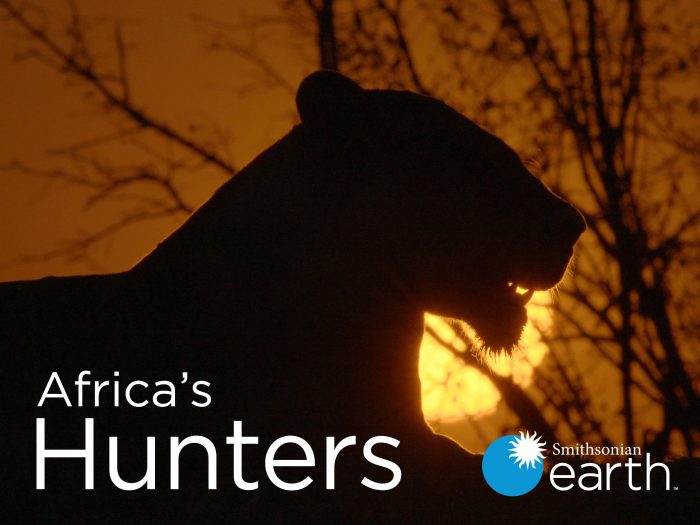RETURN TO THE DRAMA OF THE LUANGWA VALLEY WITH “AFRICA’S HUNTERS”
NEW EPISODES NOW STREAMING ON SMITHSONIAN EARTH(TM)
NEW YORK – September 14, 2018 – Smithsonian Earth continues its epic journey through Zambia’s Luangwa Valley with all-new episodes of AFRICA’S HUNTERS. This stunning series takes viewers into the backyard of some of Africa’s greatest predators, following the lions, leopards, wild dogs and hyenas that call the region home. The second season picks up from where we left our amazing cast of characters just a year ago – checking in with the lonely lion cub Misfit of the Nsefu pride and introducing us to the new leopard queen Olimba, who’s taken over from Kamuti’s rule. Along the way, witness the triumphs of a hard-earned kill, the heartbreak of loss and the bonds of brotherhood that endure in the Luangwa Valley. Filmed with military-grade thermal cameras that allow the filmmakers to go unnoticed at night,AFRICA’S HUNTERS captures the every movement of these predators 24/7 over the course of several dedicated years. Viewers will get an unfiltered look into the lives of these amazing creatures like never seen before. New episodes are now available on Smithsonian Earth(TM), which is available on Apple(R), Roku(R), Amazon, Android(TM) and at SmithsonianEarthTV.com.
The season premiere, THE TRIALS OF OLIMBA, picks up with a new young leopard queen named Olimba taking over the wily Kamuti’s turf. Unlike her predecessor, Olimba has yet to acquire all the tricks of the trade, from hunting antelope to evading lions, hyenas and even wild dogs. But the biggest threat to Olimba comes from yet another female leopard invading her space. Can she protect what is rightfully hers?
Subsequent episodes of AFRICA’S HUNTERS are:
Brothers in Arms
Premieres Friday, September 21
It’s time to check up on the Nsefu lion pride as they welcome seven new cubs into the fold, but can these new arrivals survive the hardships ahead? One of the cubs, nicknamed The Dreamer, strikes up a friendship with the awkward, now-adolescent Misfit. Together, they forge a special bond that bodes well for their future. Do these two unlikely friends have what it takes to survive?
Kings of Nsefu
Premieres Friday, September 28
Twin lions Chief and Notch maintain a powerful bond, both to each other and to the famous Nsefu pride over which they preside. Enter a pair of nomadic rivals, flagrantly trespassing on pride land. Will the old allegiances hold, or will the pride females be swayed by the lure of these bold interlopers? It falls on the brothers to demonstrate that they are the true kings of Nsefu.
The Lost Prince
Premieres Friday, October 5
The young spotted hyena Mizumu is high-born, the son of an alpha female who leads a troop of Luangwa Valley hyenas. Despite his royal blood, he must leave the clan and set out alone once he reaches adulthood. The wilds of Luangwa are dangerous, packed with ruthless predators. He eventually makes his way toward a rival bachelor clan – but can he convince them he’s a worthy addition to their ranks?
The Hot Springs Pack
Premieres Friday, October 12
The wild dogs of Luangwa Valley are organized, tenacious and strictly hierarchical under the leadership of an alpha pair. While cheetahs sprint and lions ambush, wild dogs rely on their stamina to wear prey out, sometimes running up to 20 miles at a time. But to maintain dominance, they’ll need to train their youngest members to hunt effectively as part of thepack – and time is running out.
Heir to the Clan
Premieres Friday, October 19
For spotted hyenas, Luangwa Valley is full of threats, including predatory lions, furtive leopards and even resentful relatives. Meet Spotty, the youngest daughter of an alpha female hyena. She’s the heir apparent to the powerful Chimbwe clan, but she’ll need to assert herself if she’s to assume her rightful place as matriarch-in-waiting. Will she survive to adulthood and take on the throne?
AFRICA’S HUNTERS is executive produced by James Smith and Martha Holmes of Plimsoll Productions. Tria Thalman and David Royle serve as executive producers for Smithsonian Earth.
Source: SE | JD

Leave a Reply